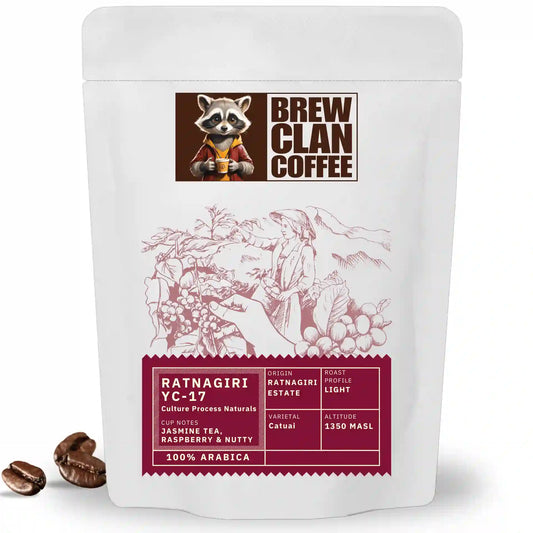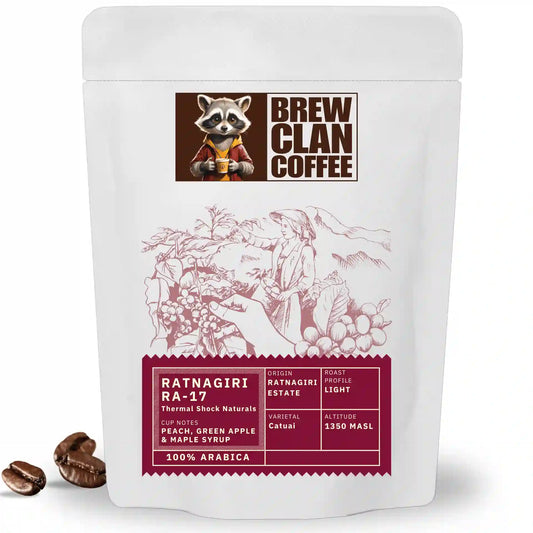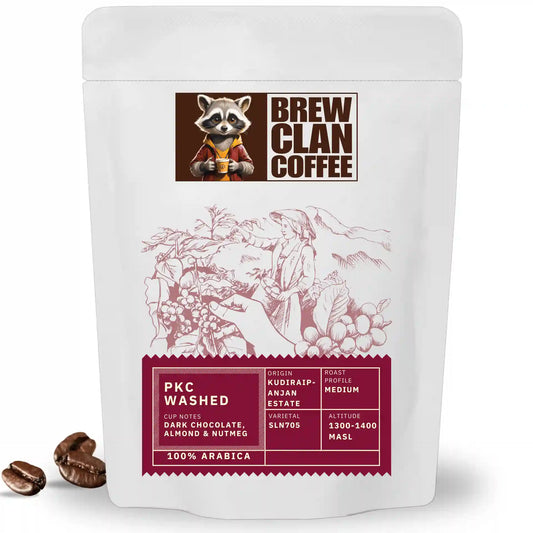
What Does Ratnagiri Coffee Taste Like? Ratnagiri Estate Flavour Profiles & Tasting Notes
Share
A Taste That Refuses to be Ordinary
Some coffees are simply pleasant. You sip, you nod, you move on.
Ratnagiri isn’t one of them.
The first encounter is almost disorienting: a burst of fruit layered over deep sweetness, a flicker of flowers, a finish that lingers like a well-told story. It’s coffee that asks for attention, not because it’s loud, but because every sip hides a small surprise.
This is why flavour profiling isn’t just a coffee geek’s pastime; it’s the key to understanding what’s happening inside that cup and why it tastes so alive.
In the next few minutes, we’ll explore the sensory fingerprints of Ratnagiri Estate, from its dependable nut-and-chocolate classics to experimental lots that flirt with jasmine, raspberry, or even sparkling citrus.
Key Takeaways
- Terroir Magic: High-altitude growing and biodiversity give Ratnagiri beans their signature complexity.
- Classic Comforts: Expect nutty sweetness, caramel, and chocolate in core Catuai lots.
- Adventurous Lots: Floral, fruity, and wine-like flavors appear in limited micro-lots and experiments.
- Brew to Explore: Pour-over for aromatics, French press for depth, espresso for balance.
- Always Changing: Each harvest offers new flavor surprises, part of the joy of specialty coffee.
Why Ratnagiri Coffee Tastes So Distinct
Before we talk flavour, it helps to know why Ratnagiri tastes the way it does. The estate sits high in Karnataka’s Western Ghats, where cool mountain air slows the ripening of coffee cherries.
Slower growth means more sugars develop inside each bean, laying the groundwork for natural sweetness.
Shade-grown under silver oaks and fruit trees, the plants enjoy rich, biodiverse soil and a gentle mist that keeps humidity just right.

Add to this careful handpicking, meticulous processing (from traditional naturals to experimental fermentations), and a focus on small, traceable lots, and you get beans with a remarkable ability to express layered flavours, something most commercial coffees can’t match.
3 Ratnagiri Estate Flavour Journeys from our Own Roasts
At BrewClan Coffee Roasters, we’ve roasted and cupped multiple Ratnagiri lots, and here are three standouts that show just how diverse this estate can be:
Ratnagiri Estate - RA - 17
Peach • Green Apple • Maple Syrup – A lively cup with stone-fruit juiciness, crisp apple brightness, and a silky maple finish.
Ratnagiri Estate - YB
Rose • Pomegranate • Black Plum – Floral and fruit-forward, with a soft, wine-like acidity and a long, sweet aftertaste.
Ratnagiri Estate - YC - 17
Jasmine Tea • Raspberry • Nutty – Delicate yet vibrant, balancing fragrant florals with berry sparkle and a gentle nutty undertone.

Flavour can naturally vary with each harvest, processing style, and even roast profile. Use these as guides, not guarantees. That unpredictability is part of the joy of specialty coffee.
Experimental Micro-lots for the Adventurous
Beyond the core profiles, Ratnagiri also produces limited micro-lots with fermentation experiments, anaerobic, carbonic maceration, or co-ferments with local fruits. These beans can taste like jasmine honey, sparkling citrus, or even toffee.
They’re bold, sometimes surprising, and perfect for those who like their coffee to feel like a tasting adventure.
How to Taste Like a Pro at Home
You don’t need a lab to appreciate these flavours. A simple at-home “cupping” can unlock notes you never noticed before:
- Grind & Smell: Grind fresh beans and inhale deeply. Dry aromas reveal hidden fruit or chocolate.
- Brew & Break: Pour hot water over the grounds and wait four minutes. Gently break the crust with a spoon and smell again, this is when floral or fruity aromas bloom.
- Slurp & Savour: Take a spoonful and slurp loudly (yes, loudly!) to spread coffee across your palate. Note sweetness, acidity, body, and aftertaste.
A small notebook or phone app can help you track impressions and notice patterns over time.
Brewing Tips to Highlight Flavours
- Pour-over (V60/Chemex): Best for floral or fruity lots, brings out brightness and aroma.
- French Press: Accentuates chocolate, nutty sweetness, and heavier body.
Freshly ground beans and filtered water make the biggest difference, no matter the method.
The Beauty of Variation
One of the most exciting things about Ratnagiri coffee is that no two lots are ever identical. Weather shifts, processing tweaks, and even the skill of the picker influence the final cup.
Instead of chasing the “perfect” tasting note, embrace the fact that each bag is a new conversation between farmer, roaster, and brewer.
Ready to Taste for Yourself?
Explore our current Ratnagiri offerings and see which flavour journey calls to you first.
Every bag carries a piece of Pearl Mountain’s remarkable story, waiting for you to brew it into life.




